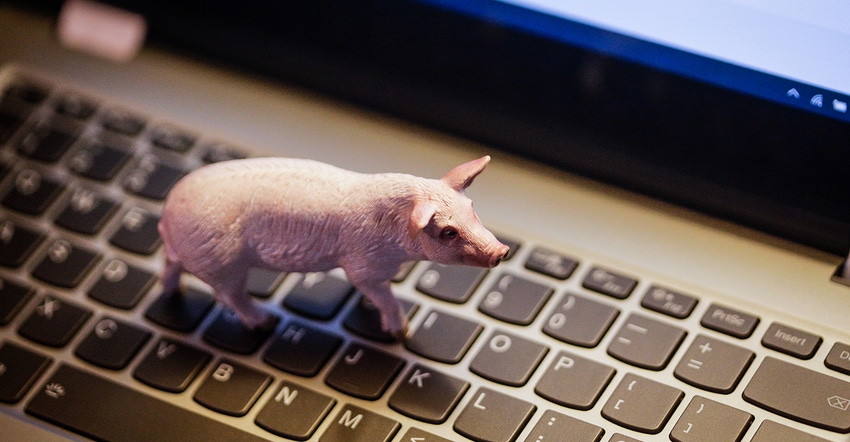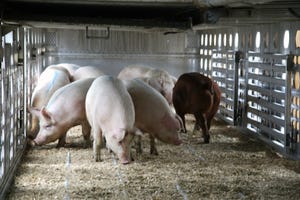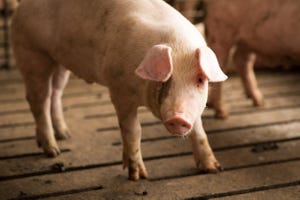Smarter technology helping the pork industry
Sensors, tools create a mountain of data points; how do we record, organize and process all data quickly enough to make a better decision?
August 9, 2023

By Nicole Boettger, MetaFarms
Recently I was cleaning off my desk and ran across this quote.
"The wisest person is not the one who thinks they know more than everyone in the room. The wisest person is the one who wants to learn something from each person in the room."
In my six months at MetaFarms, I have had a chance to learn quite a bit from people and the teams that work behind the scenes in the technology sector of the pork industry. Throughout my career in the industry, I have noted most of the pork producers are happiest being with the pigs, not doing paperwork. They approach technology with questions and open minds to create efficiency. We are facing many challenges on-farm around labor needs. While some parts of raising pigs can be replaced, it's important to note nothing can replace the human side of caring for the pigs.
Some of the key pieces of information that framed technology for me were Integration, APIs and APP's.
Technically defined as:
Integration or the combining of subroutines, software modules or full programs with other software components in order to develop an application or enhance the functionality of an existing one.
API is the acronym for application programming interface — a software intermediary that allows two applications to talk to each other. APIs are an accessible way to extract and share data within and across organizations.
APP abbreviation for application: a computer program or piece of software designed for a particular purpose that you can download onto a mobile phone or other mobile device.

MetaFarms
One of the popular areas of focus at the recent World Pork Expo centered on cameras/sensors/systems that allow producers to monitor barn conditions, feed bins and site access points in real time so they can respond quicker to any changes, challenges or emergencies.
Sensors can monitor a barn's internal and external temperature, humidity, water consumption and power from a secure mobile app that displays real-time barn conditions and provides alerts when measurements are outside the norm. These alerts can help producers identify and address costly issues impacting animal health, performance and operational efficiencies. Others measure feed in the bins and help with feed allocations and better efficiencies for delivery.
All these sensors/tools can and do create a mountain of data points. How do we record, organize and process all these data points quickly enough to make a better decision? That is the million-dollar question, and where we are making great strides. Using analytical and business logics to sort and analyze the data, using Mobile App entry in combination with Integrations/API's back into software platforms to make real time changes.
Showing my age a bit but our farm used to have hanging thermometers in the barn rooms that captured the highest temp and the lowest temp until it was manually reset and written down on the barn sheet once a day. This was used to adjust ventilation and temperature daily in the barns. Today, happy to report, we have sensors that have automated the process, allowing software controllers to adjust that based on the parameters we have set. The adage that we can better manage what we measure rings true and is part of the continuous industry improvement.
Integration processes help to reduce the lag time of data entry to have industry recognized key performance indicators. This feeds directly into our INSIGHTS Platform in the area of Sales, Feed, Nutrition, Health, Genetics and Financials.
Another focus I noted while at WPX was foreign animal disease, getting to meet one of the Beagle Brigade dogs was great, but served as a reminder to me of the daily risks that are out there and how improved training and focus can be the first step of keeping diseases out. We still need to be prepared. At the booth, I had several more conversations surrounding the topic of FAD. There was great interest in how an API allows the producer to populate data directly from the MetaFarms Movement App or Finish Platform into AgView, reducing the need for duplication of data entry. We are capturing over 13,000 movements monthly through solid, safe and secure technology.

MetaFarms
AgView, uniquely makes pig movement data instantly available, with the producer's permission, to animal health officials. This is important for rapid disease traceback on day one of a FAD outbreak. It serves as a solution for state veterinarians to use in an FAD to track swine movement and determine the extent of the outbreak. This Checkoff-funded tool is a trusted resource producers can take responsibility for – and with opt-in data sharing – it's convenient to make sure updated movement data is available to the decision makers in the moment they need it. The National Pork Board has made every effort to ensure the producer data within AgView is confidential and secure. All the data is encrypted and is not readable by outside sources. Also, all producer information is stamped as business/trade confidential data. This adds extra security as it prevents access through public disclosure laws.
Recently, the AgView system was put to the test with a "mock interstate swine disease event" and Brian Hoefs with the Minnesota Board of Animal Health had this to say about its performance. "During animal disease events, time is of the essence. The ability to trace disease origins, as well as potential spread to additional sites, is at the core of a state's ability to have an effective response. AgView has demonstrated its ability to provide essential data, including site information, contact information and movement records almost instantly during a recent mock interstate swine disease event. Communication between state animal health officials involved in the mock event was also initiated simultaneously to effectively collaborate on joint response efforts."
Let's hope, we never have to really use the system for an FAD, but it's good to know that mock test and other exercises help to improve and better protect the industry. For this concept to capture more farms, it needs to be user friendly and not require un-needed data entry.
If you would like more information on AgView, please visit the Pork Checkoff website. If you want help getting your data flowing to AgView from MetaFarms, please reach out.
I have no doubt that the agriculture community, specifically the pork industry, will continue to make improvements in smart technology. If you have questions or what to learn more, feel free to reach out to suppliers and partners in the industry. Remember that the wisest people seek to learn from others in the room.
MetaFarms Analytic INSIGHTS were used to provide some of the context and trends for this article. If you would like to discuss how days between event and entry could affect your performance and bottom line, or if you have suggestions on production areas to be included in future articles, please e-mail or call us. We enjoy being a part of the National Hog Farmer Weekly Preview team. Previous Production Preview columns can be found at National Hog Farmer.
If you have questions or comments about these columns, or if you have a specific performance measurement that you would like us to write about, please contact: Nicole Boettger via email.
You May Also Like



